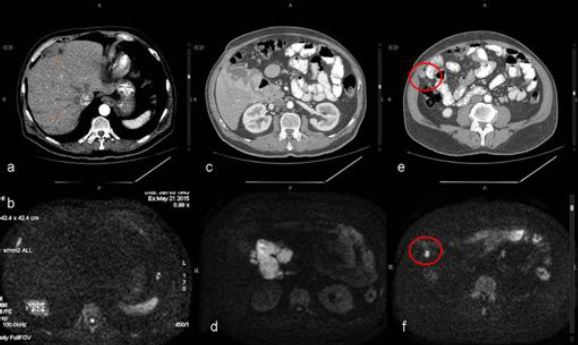Uso de la Secuencia de DWI en el seguimiento y valoración de respuesta del tratamiento de los tumores GIST
Palabras clave:
Secuencia de DWI, tumores GIST, poster, seramResumen
Objetivos
Las secuencias de difusión (DWI) son cada día más utilizadas en la caracterización de las diferentes patologías del abdomen, y en especial en patología oncológica.
Mostraremos como la DWI es útil en la detección de enfermedad (Fig. 1 y 2), en el seguimiento de la misma y en los cambios que se producen tras el tratamiento con inhibidor del receptor KIT Tirosi-Kinasa. (Fig.3 y 4)
La RM es una técnica inocua y accesible en muestro medio hospitalario y que puede ayudar al clínico a tomar decisiones, como la de modificar el tratamiento, dependiendo de la respuesta al mismo.
Material y métodos
Se realiza una caracterización de los Tumores GIST y se ha revisado la bibliografía actual, sobre el uso de la resonancia magnética y de la secuencia de difusión (DWI) en el diagnóstico y seguimiento de los mismos, así como mostrar nuestra inicial experiencia en el uso de la misma para la detección de enfermedad a distancia (Fig.5 y 6), recaídas y control de respuesta al tratamiento médico (Imatinib)
Descargas
Citas
Mi Hye Yu, Jeong Min Lee, Jee Hyun Baek, Joon Koo Han,Byung-Ihn Choi MRI Features of Gastrointestinal Stromal Tumors.
AJR 2014; 203:980–991
Choi H, Charnsangavej C, De Castro Faria S, Tamm EP, Benjamin RS, Johnson MM, et al. CT evaluation of the response of gastrointestinal stromal tumors after imatinib mesylate treatment: a quantitative analysis correlated with FDG PET findings. Am J Roentgenol. 2004; 183: 1.619-1.628.
Chun Sing Wong, Nanjie Gong, Yiu-Ching Chu, Marina-Portia Anthony, Queenie Chan, Ho Fun Lee,Kent Man Chu, Pek-Lan Khong. Correlation of measurements from diffusion weighted MR imaging and FDG PET/CT in GIST patients: ADC versus SUV. European Journal of Radiology 81 (2012) 2122–2126.
Sabine Schmidt, Vincent Dunet, Melanie Koehli, Michael Montemurro, Reto Meuli and John O. Diffusion-weighted magnetic resonance imaging in metastatic gastrointestinal stromal tumor(GIST): a pilot study on the assessment of treatment response in comparison with 18F-FDG PET/CT Acta Radiol OnlineFirst, 2013 as doi:10.1177/0284185113485732
Rajan Rakheja, Hersh Chandarana, Linda DeMello, Kimberly Jackson, Christian Geppert, David Faul, Christopher Glielmi, Kent P. Friedman Correlation Between Standardized Uptake Value and Apparent Diffusion Coefficient of Neoplastic Lesions Evaluated With Whole-Body Simultaneous Hybrid PET/MRI. AJR 2013; 201:1115–1119
Hyunki Kim, Kimberly S. Keene, David B. Sarver, S. Kyle Lee, T. Mark Beasley, Desiree E. Morgan, James A. Posey, III Quantitative Perfusion- and Diffusion-Weighted Magnetic Resonance Imaging of gastrointestinal Cancers Treated With Multikinase Inhibitors: A Pilot Study Gastrointestinal Cancer Research .May–August 2014. Volume 7 • Issue 3–4
M.J. Parada Blázquez, B. Vargas Serrano, F. Awad Breval, R.M. Miranda Matilla, M.J. Tienda Flores y J.C.Hernández Cadena Hallazgos radiológicos en los tumores GIST. Radiología. 2014;56 (Espec Cong):409
Radiología Abdominal. SEDIA. Vol 7.nº 1. 2010.
Nan-Jie Gonga, Chun-Sing Wonga*, Yiu-Ching Chub and Jing Gua Treatment response monitoring in patients with gastrointestinal stromal tumor using diffusion-weighted imaging: preliminary results in comparison with positron emission tomography/computed tomography . NMR Biomed. 2013; 26: 185–192


